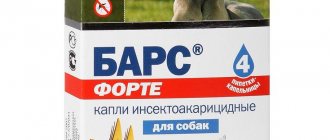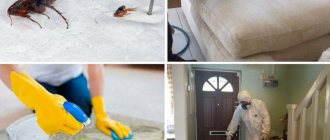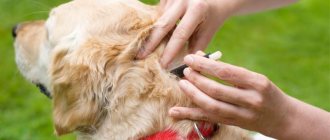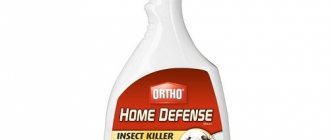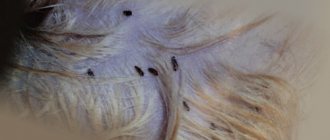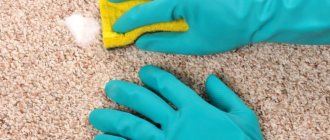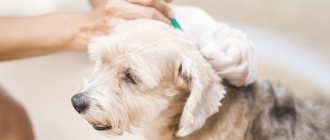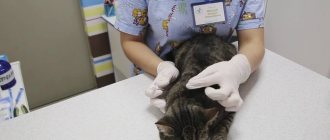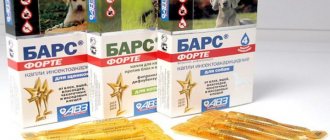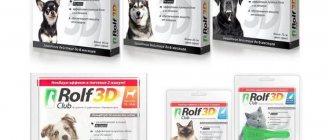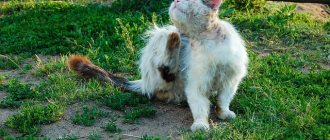In the article I will describe the dog flea: its appearance, what it looks like and biological features. I’ll tell you how to understand it yourself and what the symptoms are. I’ll tell you how to remove and get rid of fleas in a domestic adult dog and puppy using folk remedies and special preparations and medications. I will give you ways to remove parasites from furniture and carpets and what to do. I'll tell you whether dog fleas are dangerous for people.
Flea remedies for dogs: how to buy the right one
For modern dog breeders, the issue of choosing medications is no longer particularly acute: any veterinary pharmacy or pet store has dozens of antiparasitic drugs.
The problem, rather, lies elsewhere: choosing a drug suitable for a dog of a certain age, weight and/or physiological state is another task. There are really a lot of medicines, but it can be difficult to buy what you really need. Therefore, you need to understand what options exist and when it is advisable to use them.
Here are the basic principles that should guide your purchase:
- In cases of severe infestation (when the dog's fur is literally teeming with parasites), prior consultation with a veterinarian is necessary.
- The number of parasites already present. In particular, with a mild degree of infestation, a cheap collar or a couple of drops of essential oils applied directly to the coat is often sufficient.
- You need to consider how often the animal walks (and whether it walks at all) outside. Owners of hunting and service pets that often visit forests should pay special attention to this issue. Perhaps in this case it is necessary to place more emphasis on protection not from fleas, but from ticks (known carriers of deadly diseases).
- The frequency of bathing the dog is also taken into account. The same hunting dogs often swim, getting to the shot game. They need especially reliable protection (in the form of “long” drops or high-quality collars).
- The younger the animal, the softer the protection should be. Thus, many drip products cannot be used for puppies under at least two months of age. The components they contain may be too aggressive. In such cases, we recommend using folk remedies. Their effectiveness is lower, but when used carefully they are much safer (but you should not forget about the possibility of allergies).
There is another problem, the relevance of which is very high. Inexperienced breeders, having once washed the dog with shampoo with an antiparasitic effect, are very soon surprised: the dog again finds itself “covered” with fleas, although before that they seemed to have been dealt with.
Using folk remedies at home
At home, you often need something simple, cheap, but quite effective. But! There is one caveat. Many breeders sincerely believe that such products are completely safe for animals, and therefore do not think about the correct dosage and use. This usually doesn't end well.
Traditional medicine products often provoke the development of allergic reactions, and therefore should be handled with care.
Garlic for flea control
Garlic is good not only when taken internally: it has also proven itself in the fight against external parasites. Grind two cloves on a fine grater, then add boiled water and leave for eight hours. The resulting composition (pre-filtered) is rubbed onto the withers area and the base of the skull.
Important! The composition should be applied only in places where the animal cannot lick it off. This plant is quite toxic for dogs, and therefore its excessive and improper use can lead to serious poisoning.
How to use essential oils?
Many essential oils have been used by humans as antiparasitic agents and repellents since ancient times. The following Oils have proven themselves to be the best in the fight against fleas:
- One of the best remedies is wormwood oil.
- Eucalyptus oil and eucalyptus tincture.
- Lemon and orange oils. One of the best options, which, among other things, has an excellent repellent effect.
- Anise.
- Peppermint.
- Thyme.
- Pine essential oil.
- Lavender.
- Tea tree. It is also actively used in folk medicine and veterinary medicine, not only as an antiparasitic agent. This product is good in the treatment and prevention of many skin diseases.
- Cedar. As in the previous case, this oil has proven itself well in ridding animals of ectoparasites and the consequences caused by their activities.
How to apply essential oils correctly?
Many owners are confident that essential oils can be used without restrictions, since they are “completely natural and therefore absolutely safe.” Alas, this is somewhat wrong. The fact is that they are concentrated products, and therefore, when applied directly to the skin, they may well contribute to the development of quite serious chemical burns.
Therefore, essential oils are applied in very small quantities, directly to the coat. As in the case of garlic, they are smeared on the withers and base of the skull so that the animal cannot lick off the antiparasitic composition.
Celandine (herb)
Do not confuse “real” celandine (i.e. grass) with a medicinal product that has a similar name. Use it as follows:
- First, an infusion is prepared. To do this, pour one teaspoon of dry herb into one glass of boiling water and infuse the resulting mixture for half an hour. Then the composition must be filtered through a sieve. It should have a rich yellow-brown hue and a pleasant aroma.
- The infusion is added to the bathing water for cats. In addition, it can be used for cleaning indoor floors.
Important! This plant contains more than 20 alkaloids (i.e., very poisonous compounds). All of them are toxic to dogs, and therefore the product is used with extreme caution. The broth should not be allowed to enter the animal’s digestive system. If there is an alternative, it is better to use it.
Pharmacy products: preparations for killing fleas, features of their use
Today on the shelves of pet stores and veterinary pharmacies you can easily find ten (if not hundreds) names of antiparasitic agents designed to kill blood-sucking insects. The most common pharmaceutical products are drugs in drop form. They are easy to apply and dose, they have a long-lasting and well-defined effect.
Possible side effects
Fortunately, today's dog owners don't have much to worry about: side effects usually do not develop. Moreover, in most cases they speak either of a gross overdose, or of individual intolerance by the dog’s body to the components of the medicine.
In these cases, the following warning signs may develop:
- Flaky, white and thick foam begins to come out of the pet's mouth.
- In severe cases, it comes to seizures, very similar in appearance to epilepsy.
- Some insecticides in overdose do not hit the nervous system so hard, but their effect is still expressed in a shaky and uneven gait, as well as strange and unnatural behavior of the treated animal.
What to do if your dog is poisoned
But what if the dog is poisoned? If at least one of the above symptoms appears, or in cases where the owner is worried about something else, you should immediately take the dog to the veterinarian. If for some reason it is impossible to do this quickly, the dog is given activated carbon at the rate of one tablet for each kilogram of live weight.
And one more nuance. The more your pet drinks, the faster its body will be able to eliminate excess toxins through urine and feces.
Flea shampoo for dogs
Any anti-flea shampoo is only suitable for one-time extermination of fleas already present on the animal’s body. Such products are not suitable for long-term protection.
The following varieties have proven themselves best:
- Dana.
- Phytoelite.
- Leopard.
In general, these shampoos are produced by the same companies that produce drip medications for fleas.
Drops on the withers: features of application
Despite the variety of antiparasitic agents, drops on the withers are considered the most effective. They are effective and retain their effect for a long time.
How to apply antiparasitic drops correctly
There is nothing complicated in this process, but you need to remember one important circumstance: all drip products are created on the basis of volatile and rather toxic components. If you use the product incorrectly, your dog can be poisoned.
How to apply the medicine correctly so that there are no such consequences? In fact, there is nothing complicated about this:
- They should be applied strictly to the withers area and the base of the skull. It is imperative to ensure that there are no scratches, wounds, abrasions, or signs of inflammation on the skin in this area. Their presence leads to the fact that the drugs in concentrated form enter directly into the general bloodstream. This is dangerous and leads to severe poisoning.
- When applied, it is strictly forbidden to rub or rub the drops into the skin! Failure to comply with this rule may lead to poisoning of the animal.
Important! You cannot bathe your dog until at least a week has passed since the treatment! In some cases, the manufacturer generally advises waiting at least two weeks.
This is due to the fact that the active substances are not immediately “absorbed” by the skin and sebaceous glands. If you do not wait, the effectiveness of the treatment may be significantly reduced.
Large breeds and “kids”: features of drops for different dogs
Owners should be aware that large breeds have their own characteristics, which must be taken into account when processing. And we are not talking about some physiological nuances of their body, but about the characteristics of the means used. It all depends on the specific drug. Some are produced universally, with the same characteristics for all, while others are divided into several types:
- For "compact" dogs. This includes both small breeds and puppies.
- For medium breeds.
- For large animals.
However, usually breeders do not need to go into such details, since the packaging of the drug should indicate for which animals it is intended. In addition, many manufacturers additionally use color differentiation, producing drugs for dogs of different weight categories, packaging them in pipettes with certain colors.
Important! We categorically do not recommend confusing them, since the concentration of active substances in these cases is completely different! A small dog can be easily poisoned by treating it with a product for “giants” weighing 50 kilograms or more.
But pouring the contents of several pipettes intended for babies onto a large dog is also not the best. In this case, the dog will receive severe poisoning, which can be fatal.
"Leopard"
Bars drops are produced on the basis of one of the newest and highest quality insecticides, fipronil. It accumulates in the upper layer of the epithelium, as well as in the sebaceous bulbs, which ensures a high-quality and long-lasting effect of the drug (at least one month). The drug can be applied only when the pet is at least a couple of months old.
"Advocate"
The drug contains a combination of imidacloprid and moxidectin. Because of this, there is a strict age limit - the animal being processed must be at least 2.5 months old (or at least nine weeks, but no less).
Weight – at least four kilograms. You need to pay special attention when purchasing: “Lawyer” is produced for animals belonging to different weight categories! As in the previous case, the effect of the treatment lasts for about a month.
Advantix
The drug has a pronounced effect against not only fleas, but also ticks, mosquitoes and lice eaters.
Contains imidacloprid and permitrin. It is prohibited to handle dogs younger than seven weeks and weighing less than one and a half kilograms. Available in four types: for pets from 4 to 40 kilograms. Advantix is distributed throughout the coat and upper layers of the skin, maintaining effectiveness for up to four weeks.
"Dana"
Contains fipronil and diazinon. The latter has a pronounced and high-quality effect against not only bloodsuckers, but also the larvae of many parasitic worms (including heartworms). Because of this, “Dana” is especially valued by breeders living in areas disadvantaged by these pathologies.
But! There is one peculiarity. The product contains organophosphorus compounds, which are very dangerous for mammals.
Therefore, it is allowed to process animals that have reached at least three months of age, not younger.
Frontline
One of the highest quality products (among those presented on the domestic market). Its main advantage is its truly prolonged action, which can last for almost two months. Moreover, this is the only drug that can really be prescribed to pregnant and even nursing pets without fear for their offspring.
The medicine is available not only in the form of drops. Frontline NexgarD is available in tablet form. And they are really effective against fleas and other ectoparasites! Can be prescribed starting from six weeks of age.
"Inspector"
Contains moxidectin and fipronil. The drug does not have any outstanding features. It can be applied starting from seven weeks of age. In addition, the manufacturer claims a powerful repellent effect against ticks, so the product is indicated for hunting and guard dogs, which often suffer from “attacks” of these parasites. The “inspector” will help protect your pet from dangerous diseases transmitted by ticks.
"Celandine"
As in many of the cases described above, the drug contains two active ingredients: fipronil and permitrin. The product was developed and produced by domestic pharmacists, and therefore is relatively cheap and accessible.
In addition, the drug is very effective, and permitrin, which is part of it, acts not only on ectoparasites, but also on the young of some parasitic worms. Celandine is prescribed strictly from two months, the dog’s weight should not be less than half a kilo.
Hartz
One of the most effective means. Produced by an American company of the same name and world famous. Contains phenothrin and methoprene. This drug is a real record holder for the duration of action: just one treatment is enough for about three months.
Such a powerful effect is due to high-quality and “serious” components, but... Only dogs aged four months and older can be treated. It is strictly prohibited to use Hartz for lactating and pregnant bitches.
Stronghold
It is also one of the “classics”, known and loved by domestic breeders. This popularity did not arise out of nowhere: the product, which contains selamectin, allows you to fight not only fleas and ticks, but also parasitic worms with equal success.
As for the latter, the drug is capable of destroying not only their larvae, but also fully grown individuals. Stronghold can be used from approximately six months of age.
Butox
Strictly speaking, these are not ready-made drops, but only a “semi-finished product” for preparing them yourself. The main component of the product is a very powerful and effective insecticide, deltamethrin. The problem is that Butox is also quite toxic to mammals. Therefore, they are prohibited from treating puppies, pregnant and lactating bitches.
Barrier
The active ingredient is fipronil, already known to the reader. In fact, Barrier is a complete analogue of Barca. The protective effect lasts up to two months. Animals that have reached three months of age and weigh at least two kilograms can be treated. It is strictly forbidden to wash the dog if less than two days have passed since the treatment.
BlochNet
A product with an interesting name is produced by domestic manufacturers. The composition includes fipronil, as well as benzyl benzoate and dimethyl phthalate.
BlochNet perfectly protects against fleas for three (!) months, fully justifying its name. Animals at least three months old can be treated.
Rolf 3D
The product contains fipronil, as well as etofenprox and pyriproxyfen. It has pronounced effectiveness against all ectoparasites, and the effect of treatment lasts for about two months. Rolf 3D is strictly prohibited for use on animals under two months of age, as well as dogs weighing less than two kilograms.
Flea spray as an alternative to drops
As a rule, you can find an antiparasitic spray on the shelves of veterinary pharmacies and pet stores. Manufacturers and brands are the same as those just described. Many people believe that sprays are a complete analogue of drops on the withers, but this is not so:
- Unlike drops, these products are distributed only through the coat and the very top layers of the skin. Accordingly, you can’t count on their very long-term effect.
- In the production of sprays, insecticides and repellents are used that are less “vigorous”, and therefore younger or older pets can be treated with sprays.
How to remove from carpets and furniture
These parasites live not only on the dog, but also in furniture, bedding, and carpets. It is better to throw away the dog's bed immediately.
Upholstered furniture and carpets are first washed well with washing shampoos, and then treated with any of the insecticidal preparations in the form of a spray or fumigator: Raptor, Kombat, Raid, Dichlorvos, etc.
If there are a lot of them, it is better to invite a special service, whose employees will treat the entire area of the room with potent agents. During this procedure, all residents should be removed from the apartment or house.
The drug neostomozan has a good effect.
1 ml of product is diluted in 3 liters of clean water, and then sprayed onto furniture, carpets and baseboards using a spray bottle. After the procedure, all surfaces are vacuumed well.
Drops are applied to the animal’s withers
Antiparasitic collar or drops?
In addition, many breeders prefer to use an anti-parasitic collar. But it is difficult to consider it a full-fledged replacement due to the specific qualities of such protection:
- Collars are often made from the cheapest and roughest materials. This leads to the fact that they cannot be properly fixed on the dog’s neck.
- Dogs are very “gnawing” creatures, and therefore there is a high chance that the dog, having thrown off the “harness” from its neck, will first slobber all over it thoroughly. Nothing good will come of this, since insecticides taken orally are a strong and very unpleasant toxin.
- Finally, if the dog is large, then there will be no fleas on the neck, but they will feel great on the rump. The effect of the collar, unfortunately, does not extend that far.
But there are also positive nuances. Firstly, collars can in most cases be used to protect pregnant and lactating bitches. Secondly, they are also used to protect puppies.
Consumer Reviews
Alexander, 42 years old, Voronezh.
“I often go hunting with my dog. And she always comes back covered in fleas. And fleas are everywhere! And in a booth, and on a collar, on a leash! They are visible to the naked eye. I have been using Frontline spray for a long time. Although it is expensive, fleas die immediately after using it. A very effective remedy. I wouldn’t trade it for anything.”
Varvara, 35 years old, Moscow.
“I have had a dog for ten years now. I live in a private house, so walks with the dog in nature are almost inevitable. My Black constantly brings fleas home. I have tried a lot of things, but for the last three years I have been successfully using Dana drops. There were no side effects or allergic reactions. “Dana” protects Black for almost three months, then I drop the drops again. For me, it’s an excellent drug!”
What can be used for a pregnant or nursing dog?
First, let's look at what products you can use if you need to kill fleas on a pregnant dog:
- In the first half of pregnancy, it is allowed to use essential oils and other traditional medicine. They are completely safe for unborn babies.
- In the second half of gestation, the use of drops, collars and sprays is already allowed, but before this we recommend consulting with a veterinarian. If the pregnancy is not going according to plan, it is not recommended to use medications.
To help a nursing dog, you can use the same options that we described above. But there are several nuances:
- We would not recommend using medications, even if the manufacturer itself allows it. Their components will almost inevitably end up in the puppies’ digestive system, and this is extremely undesirable.
- The most optimal remedy in this case would be essential oils, especially wormwood oil. It perfectly repels fleas, but does not pose a threat to the health of babies.
- For the same purposes, you can use fresh wormwood herb and eucalyptus tincture. They are used to treat the area where the mother and babies are.
How dangerous are flea bites for a puppy?
Flea bites are much more dangerous for babies than for adult dogs. In addition to the severe itching, which bothers adult dogs and makes the baby whine, constantly itch and cannot find a place for himself, fleas on a small puppy are dangerous for a number of reasons.
- Puppies have not yet developed their immune system, and they are often defenseless against infectious agents that are transmitted by fleas through a bite.
- Children are much more likely to suffer from allergic reactions from flea saliva enzymes.
- With extensive bites, anemia develops due to significant blood loss relative to the weight of the puppy.
- The worms with which fleas infect their prey are much more difficult for children to tolerate: exhaustion sets in, stool changes, fur becomes dull, and eyes become sour.
Therefore, even before mating, it is necessary to treat the bitch with a long-lasting effective remedy so that during the period of whelping and lactation she is protected from parasites, and along with her the future brood. These can be drops, a tablet, or, as a last resort, a collar, which is best removed after conception.
What means to use to kill fleas and larvae in the external environment?
It is immediately necessary to emphasize one important circumstance: if adult parasites and their larvae in the external environment are not first destroyed, the fight against them will turn into a rather useless undertaking. In addition, in advanced cases, it may turn out that fleas, deprived of the opportunity to attack a protected dog, will begin to intensively “gnaw” the owner of the animal, as well as members of his family.
Important! It must be remembered that the parasites that are visible on the dog’s body make up no more than 23-30% of the entire flea population.
All other fleas (including larvae) live somewhere in the house itself. They love damp and shaded places, ideal for cracks and potholes in flooring, walls, etc. There have been cases when entire “deposits” of flea larvae were discovered under the linoleum in old houses.
The larvae feed on a variety of organic matter, which includes microscopic flakes of skin, feces, and other “goodies.” The less often wet cleaning is carried out in rooms, the more fleas will eventually be in the room.
Using Vinegar
A very simple and cheap product with impressive effectiveness. Of course, you should only use table vinegar of 9% concentration. It is mixed with boiled water in a 1:1 ratio.
Fill any household spray bottle with the resulting mixture and carefully “pouring” it over all the cracks, potholes, and other suspicious places. You will have to do this for three or four days. The treated room is thoroughly ventilated. We note, however, that it will not be possible to completely get rid of the “flavors” of the bite right away.
Tar soap against fleas
Most often, tar soap is used to wash a pet, but it is still wiser to use this product to disinfect the external environment. The fact is that the surface of the skin of dogs is protected by a thin layer of secretion from the skin glands. Soap washes it away too quickly, which leads to undesirable consequences (including dermatitis, dermatoses and eczema).
To destroy fleas and parasite larvae in the external environment, the soap is rubbed on a fine grater and mixed with hot water. Take about ¼ piece per bucket. If the owner does not like the specific smell of tar soap (which, by the way, dissipates rather poorly), then ordinary laundry soap can be used with the same success.
Essential oils
Many essential oils are excellent repellents, and therefore they can and should be used in the fight against fleas. Below we will describe how and what types of them to use for direct treatment of a dog, but for now we will consider the method of “disinfecting” an apartment:
- Oils can simply be dropped into cracks and potholes in both flooring and walls.
- Experienced breeders advise adding them to water for washing floors. It is recommended to add 25 drops of the selected product to one bucket.
- Oils can be mixed with water at the rate of four drops per liter, after which any household spray bottle can be filled with the resulting mixture. It is used to treat the most difficult to reach places in the apartment.
In both cases, the products are extremely effective, allowing you to completely clear the room of adult parasites and larvae in a few weeks.
Where does a small puppy get fleas?
There are several ways for a small dog to become infected with fleas, and the older he is, the more there are, and the higher the risk of having bloodsuckers.
- The smallest puppies are most likely to become infected with parasites from their mother, who brought them to the family on her own, as she is forced to periodically leave the puppies.
- A puppy that has already been handed over to new owners could have flea eggs, larvae or adults remaining on its fur, which, during reproduction, began to pester the baby more actively.
- When the dog has already gone out into the world, then on the street, along with new impressions, the possibility of a flea attack awaits him, and it is possible that some frisky flea will jump on the puppy.
- If one or more pets live in the same room, then this is also a likely source of fleas in the baby.
Important! If there are other animals living in the house, it is better to periodically check them for the presence of bloodsuckers in order to remove them in time and not endanger the puppy.
